Article and Photos by Michele Bakacs
Ahoy There Matey! Rutgers Environmental Stewards Take Their First Boat Trip on the Raritan River
On May 3rd the Middlesex class of Rutgers Environmental Stewards took the water. This afforded them a rare opportunity to see the Raritan River up close by taking a 2 hour boat trip on the new R/V Rutgers. The R/V Rutgers is a new boat operated by the Department of Marine and Coastal Sciences. This 36 ft. (11 meter) aluminum landing craft is a 20 passenger vessel and supports a wide range of educational and scientific needs such as trawling, grab sampling, diving, water profiling, coring, AUV operations, etc. Faculty can reserve the vessel so students can get a first-hand look at the Raritan River ecosystem and the human impacts to the watershed.
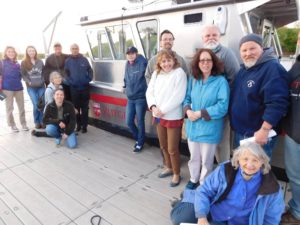
This is part of a larger effort by the Rutgers Collaborative for Research and Education to “Bring the River to your classroom” and works to support faculty efforts in engaging students and the community in Raritan River data and science through data activities.
The Rutgers Environmental Stewards program trains volunteers on important environmental issues affecting New Jersey and helps them make a difference in their own communities. The program consists of 60 hours of classes offered around the state on topics including habitat protection, climate change, geology, soil health, alternative energy, invasive plants, environmental policy, pollinators, and much more. Stewards complete a 60 hour internship of their choosing in order to become certified. Optional field trips are included. Anyone can become an Environmental Steward regardless of background.
The Stewards met the boat in Boyd Park in New Brunswick at the Class of 1914 Boathouse and were welcomed by the boat’s captain Chip Haldeman, and first mate Nicole Waite. Joining us on our trip was Dr. Heather Fenyk, Director of the Lower Raritan Watershed Partnership, and Dr. JeanMarie Hartman, Professor in the Department of Landscape Architecture. Heather and JeanMarie provided a rich history of the Raritan and identified points of interest including shale outcrop geologic formations, the Lenape Trail connection to the River, noted flora and fauna, as well as the industrial legacy of contaminated sites, old factories, and the Edgewater Landfill.
First mate Nicole taught the Stewards how researchers monitor water quality and trained them on collecting data using YSI water monitoring probes to test for dissolved oxygen, pH, temperature, and salinity. We also saw 2 Bald Eagles, countless Ospreys, Cormorants, and vast marshland. The salt marshes are mostly dominated by Phragmites australis, an invasive grass known as Common Reed, but we also saw native Spartina alterniflora (Salt Marsh Cordgrass) holding its own at the fringes of the saltmarshes.
Overwhelmingly the Stewards walked away with a new appreciation of this fantastic natural resource that most of us take for granted. Most people see the Raritan River as a place to avoid, to view from afar from the Garden State Parkway or Route 1 Bridge. This experience helped the Stewards better understand the River that lies in the heart of their community, and the importance of making sure it is cleaned up and protected.
Keep an eye on the LRWP blog for information about how to register for the Rutgers Environmental Steward class of 2018!
Dear Friends of the Lower Raritan Watershed –
It may be hard to believe, but many of the shorebirds that stop through the Lower Raritan Watershed have started their southern migration. Keep a look out for sanderlings, black-bellied plovers, red knots, least sandpipers and short-billed dowitchers. Knowing that our avian friends are already on their return trip home is a good reminder to get out in the field and enjoy the summer while it’s here!
We’ll celebrate the last last bit of summer at our next meeting, an after-work picnic on World Water Monitoring Day 2017. Join us in New Brunswick’s Boyd Park on Monday September 18 from 5:30-7:30pm, and bring your own picnic or something to share. We’ll supply beverages, paper products and dessert. Friends and family members welcome! (RSVPs requested). The evening will include water quality monitoring, project updates and a Raritan River “story slam” with coLAB Arts. Do you have a special Raritan River memory? Perhaps you swam in the Raritan as a kid, or have a story from a recent clean-up? Let us know! We are looking for 4-5 people to tell their stories on Sept 18. Storyteller confirms requested by August 31.
See you in the watershed,
Heather Fenyk, President
Lower Raritan Watershed Partnership
Water Protectors in Standing Rock, North Dakota protesting the Dakota Access Pipeline brought attention to serious flaws in the federal environmental review and approval process for crude oil and natural gas pipeline projects. The Water Protectors argued that all infrastructure projects need to include a truly comprehensive Environmental Impact Statement (EIS) that evaluates impacts to our natural and cultural assets.
While the federal oversights affecting Standing Rock were particularly egregious, the legacy of compromised Federal Energy Regulatory Commission (FERC) environmental review processes should be of concern to New Jersey residents as well. Oil and gas pipelines already fragment our environment as they crisscross the state. Our Lower Raritan Watershed may be impacted further by the proposed. This project includes a 3.4-mile-long, 26-inch-diameter pipeline loop in Middlesex County, and a 23.4-mile-long, 26-inch-diameter pipeline loop (called the “Raritan Bay Loop”) beginning at the Middlesex County coast and crossing New Jersey and New York State marine waters.
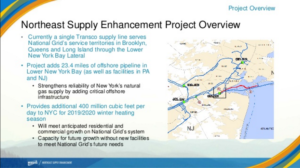
Because the Lower Raritan Watershed Partnership has concerns that the pipeline would have irreversible impacts on our communities, watershed ecology and marine habitat, we joined dozens of other concerned citizens and environmental groups at the April 20 meeting of the Middlesex County Freeholders to encourage elected officials to take action on a project that would pose significant risks. The Home News covered our public statements, and the Middlesex County Freeholder’s response.
And on April 25, the LRWP applied for intervenor status to address the Federal Energy Regulatory Commission (FERC) on the Williams/Transcontinental Application for the Northeast Supply Enhancement (NESE) Pipeline Project (Docket Number CP17-101). Becoming an intervenor provides legal standing in the proceeding, and obligates FERC to address any comments we may submit. The LRWP included the following in our application for intervenor status:
“The Transco Pipeline proposals pose significant risks to our Central New Jersey communities. These projects will solely benefit New York City markets, yet our New Jersey communities would bear significant public health and economic risks – including increased rates of leukemia, lymphomas, respiratory disorders and other diseases – while receiving little or no benefits. We must not expose our local communities to a high-risk proposition with little to no reward.
The Transco Pipeline proposals will harm our environment and the habitat of our Raritan Watershed and Raritan Bay. The building of pipeline infrastructure and the transport of natural gas from the Marcellus Shale region to New York will fragment our natural habitat, and disrupt commercial and recreational marine activities for residents and visitors. Our communities are working hard to restore landscapes destroyed by decades of industrial dumping and toxic pollution, let’s not reverse this positive trend.
The Transco Pipeline proposals are unnecessary. The Transco Pipeline would be a redundant expansion of industrial natural gas infrastructure through our Middlesex County, Somerset County and Bayshore communities. The LRWP recognizes that aging rail, bridge and other infrastructure that currently accommodates fuel transport poses risks that could lead to devastating spills in our waterways. This serious concern that can be addressed by two-pronged strategy: significant investment in the repair and maintenance of our existing infrastructure, and shifting investments to safe, clean renewable energy.
The Transco Pipeline proposals are not what our communities want. The overwhelmingly negative feedback on the project during community meetings has made it clear that this project does not have the support of community residents!”
Article by LRWP Board President Heather Fenyk
Starting from a belief that enduring environmental values will help us withstand current shifts in political winds, the LRWP is initiating a series of short blog posts to reflect on the normative standards that structured the last several decades of environmental politics in New Jersey.
Throughout this series we will draw attention to those actions that relate most directly to improving the the health of our Lower Raritan Watershed. We will also highlight other successful regional approaches that we can learn from to benefit our Lower Raritan River and local streams. Topics will include state-based policy making as well as alternative approaches including court actions, collaborative politics, and “private” pathways e.g. land trusts, consumer purchasing power and business actions to achieve sustainability. We also expect to explore mitigation banking, and proposals for stormwater utilities. In short, we want to identify a compendium of actions that might be brought to bear to further protect, enhance and restore our central New Jersey environmental landscape.
In this first entry we observe that while federal legislative changes may not currently be pro-environment (see our blog post here on environmental headlines), alternative pathways to positive environmental outcomes can be as simple as holding our state Department of Environmental Protection accountable for specific promised actions to protect our rivers, streams and watersheds. For example, we can regularly check in with NJDEP to request updates on the following on-going initiatives:
-Toxics reductions initiatives
-Water Quality Standards
-Maintaining the NJDEP water quality program
-Non Point Source reduction planning
-Communication of EPA/NJDEP TMDL prioritization work
-Legislative updates
-Permits updates
-Innovations
-Grants and loans, funding opportunities and state priorities review
Institutionalization of all the above on-going project and program efforts at NJDEP speaks to a on-going commitment to environmental priorities for New Jersey’s future. As environmental non-profits and concerned citizens we must regularly articulate our expectations associated with these priorities and hold NJDEP accountable for meeting our expectations.
With support from the EPA Urban Waters Federal Partnership and from New Jersey’s Watershed Institute, from July 26-28 the LRWP joined dozens of other urban waters communities from around the United States and Puerto Rico for the 2016 Urban Waters National Training Workshop in Washington, DC.
The Urban Waters Federal Partnership, now in its 4th year, is an innovative union of 14 federal agencies working to provide integrated support to communities – particularly under-served and economically distressed communities – as they transform their local urban waters into treasured centerpieces for community revitalization.
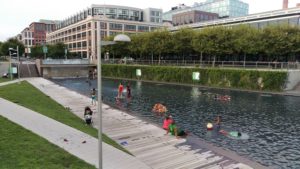
Splash pool along DC’s Anacostia River – image, Heather Fenyk
At the Training Workshop communities told stories of how their urban rivers, streams, forests and wetlands are polluted, degraded or inaccessible. But they also highlighted examples of how they are working to measure the relationship between clean, safe and accessible waters environments and improved public health, stronger local economies and lower crime rates.
Mayors talked about making clean water a part of every conversation, and about turning to the water to revive civic life. Volunteer water quality monitors talked about the new perspectives gained by “discovering” regional landscapes through their work. And community organizers showed how process is as important as the final product in terms of sustaining the work to clean up our rivers and streams.
We also had the chance to tour areas like DC’s Anacostia River – a slow-moving diurnal water body dotted with CSOs – to be inspired by how creative landscape design integrates CSO infrastructure, safe river access and play spaces to formerly derelict sites.
As groups from around the country shared how deeper connections to our local water bodies can bring community energy that will lead to healthier urban waters, improved public health, strengthened local businesses, and new jobs it became clear that our work in the Lower Raritan Watershed contributes to an important national movement to clean up our urban rivers, streams and watersheds.
By: Heather Fenyk
Part of the fun of reading comic books when I was a kid was coming across ads for the absurd: Monster Size Monsters! X-Ray Vision Glasses! Kung-fu Sandals! (AUTHENTIC! Worn for Centuries by Oriental Fighting Masters!) But my absolute favorite adverts included invitations to “Own A Bowl Full of Happiness.” For just 49¢ plus $2.99 shipping, you could raise your own “trainable” insta-pet, the Sea Monkey.
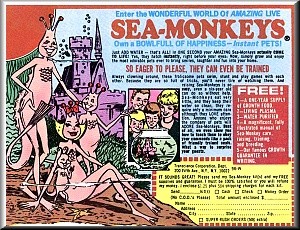
Sea-Monkey ad from 1970’s comic book
Sea Monkeys fall into a general group of organisms including brine shrimp and “fairy shrimp” that, with the proper mix of nutrients and chemicals, can be stored in dry form and then “revived” with a dose of plain tap water.
Recent rains have nourished our New Jersey swamps and freshwater marshes, transforming seeming terra firma into vernal or ephemeral ponds. These ponds – or more specifically their “fairy shrimp” inhabitants – get me out in the field looking for Sea Monkeys.
The descriptive terms for these freshwater wetland types — “vernal” and “ephemeral” — refers to their habit of appearing in spring and being short-lived or temporary. Many vernal ponds in New Jersey and elsewhere were not protected during the post-World War II building boom. But with the passage of the New Jersey Freshwater Wetlands Protection Action in 1987, all freshwater wetlands – including these temporary wetlands – were finally granted protection. Fairy shrimp benefit directly from these protection measures.
A common species of fairy shrimp in our New Jersey vernal ponds is Eubranchipus vernalis. It grows between 0.5 and 1.5 inches in length, and other than its forked tail and large, stalked, compound eyes, its most obvious features are the 11 pairs of feathery appendages it uses for swimming, breathing and feeding. It collects algae, bacteria, protozoa, rotifers, and detritus on the feather-like structures and transfers that material to its mouth by other appendages. In addition, it will scavenge dead tadpoles, mollusks and amphibian eggs.
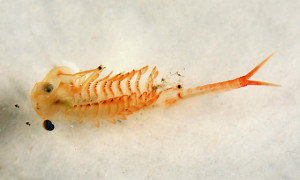
Eubranchipus vernalis. Image from www.bugguide.net
The shrimp’s reproductive strategy is fascinating. After mating, the male dies. The females are easily distinguished from males by the egg-filled brood sac on their abdomen, and the sac contains one of two types of fertilized eggs depending on the density of males in the pond. A low density of males results in thin-shelled “summer eggs,” which have a very short incubation period and hatch inside the brood sac. A high density of males results in thick-shelled “winter eggs” that eventually fall to the bottom of the pond and remain there even when the pond dries out. They will hatch the following spring, when the pond refills, and they have an amazing capacity to withstand extreme elements, including temperatures that are probably never encountered in nature: from a high of just below boiling (210 degrees) to a low extreme of -310 degrees.
The powdered thick-walled eggs of fairy shrimp are the type that my sister Julie purchased in 1978 from the back of an Archie Comic Book. It is this egg stage that enables the fairy shrimp to be distributed to other potential vernal ponds. Fairy shrimp eggs are tiny, dry granules that can be blown by the wind or picked up on the feet of animals and carried to other vernal ponds. These thick-walled, dry eggs remain viable even after 15 years, and the eggs are supposed to hatch 30 hours after being submerged in water.
Sadly, Julie’s order of Sea Monkeys never hatched. While she was perhaps permanently scarred by being duped into purchasing a package of powdered brine shrimp, I remain suckered in by the advertising and happily spend spring weekends exploring New Jersey’s vernal pools looking for my own Sea Monkeys to train.
Happy National Sea Monkey Day!
by Heather Fenyk & Elizabeth Dabundo
Join the LRWP from 9-noon on February 16th when we will hear presentations on Natural Resource Assets by John A, Miller, Princeton Hydro Water Resources Engineer and co-founder and legislative committee chair for the New Jersey Association for Floodplain Management and Rutgers Professor JeanMarie Hartman, Director of the Hartman Lab of Watershed Systems Studies at Rutgers.
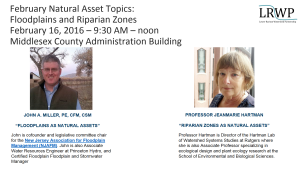
Natural Assets Map Project Background
In February 2015 at a workshop on Impervious Cover Remediation (ICR) co-hosted by the LRWP and Rutgers Cooperative Extension Water Resources, the LRWP recognized a need for tools to help communities implement Green Infrastructure (GI) and meet ICR goals. At the ICR workshop municipal representatives expressed an interest in minimizing stormwater runoff, with many of of these reps suggesting that their communities set impervious cover reduction targets. But where to start? How could towns best prioritize resources for ICR and GI implementation?
To help LRW communities on this path the LRWP researched tools that would help with strategic location of ICR and GI sites. We found references to a process called “Natural Assets Mapping” that suggests not only a prioritization process, but also provides an approach to orienting community conversations around valuation of ecosystem services and the benefits supplied to human societies by natural ecosystems.
Working with input from the Middlesex County Department of Planning we shaped a speaker series for 2016 to guide development of a Natural Assets Map for the Lower Raritan Watershed (Watershed Management Area 9), and to prime municipal conversations regarding prioritization of GI and ICR.
Our goals for the project include:
- To evaluate, prioritize and map natural and cultural assets in the Lower Raritan Watershed.
2. To support community stewardship of Green Infrastructure (GI) / Nature-Based Solutions, including:
-Informing development of GI Master Plans
-Identifying opportunities to add GI to capital projects
-Helping communities link to GI performance rates
-Helping develop design standards for GI related to identified assets.
3. To identify potential investments to optimize the existing system.
4. To advance and support stormwater management planning at County / municipal levels.
5. To improve administration of environmentalism in the LRW.
The 2016 Natural Assets Mapping kick-off
At the 2016 Natural Assets Mapping kick-off event on Tuesday January 26, LRWP Land Use Planner Angela Knowles gave an overview of the Natural Assets Mapping process as outlined by Karen Firehock at the University of Virginia. Angela provided highlights of the document we are using to guide our work (“Evaluating and Conserving Green Infrastructure Across the Landscape: A Practitioner’s Guide“) and described the various GIS layers the LRWP plans to discuss going forward.
Angela also explained how, using these layers, we will map environmental, cultural, historic, and human assets throughout the watershed in an interdisciplinary way. With GIS, LRWP communities will be able to see where particular features are found, what geographical patterns exist, and what changes have occurred over a given time period. We aim to identify the natural assets in the watershed and how they relate to other community assets so that we can conserve, and/or restore the natural features that are most valuable to communities. This further reduces the need to build engineered structures to deal with issues like stormwater runoff in favor of more cost effective, natural solutions.
At the kick-off, attendees brought attention to various environmental, cultural, historic, and human assets that they personally thought were valuable in a group mapping exercise. The LRWP will devote much of the year to reaching out to community members around the LRW to pinpoint certain areas that may be less known to many, but no less valuable.
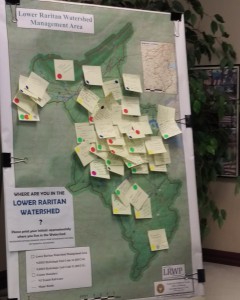
Speaker themes for 2016 include natural resource assets, cultural and historic assets, transportation and mobility assets, seeing brownfields as community assets for restoration, and economic assets, innovation, & regional planning. We are very excited for the opportunity to have state and regional experts on these topics join us for these presentations, and we hope you will join us as well! Please see our events page for more information.







